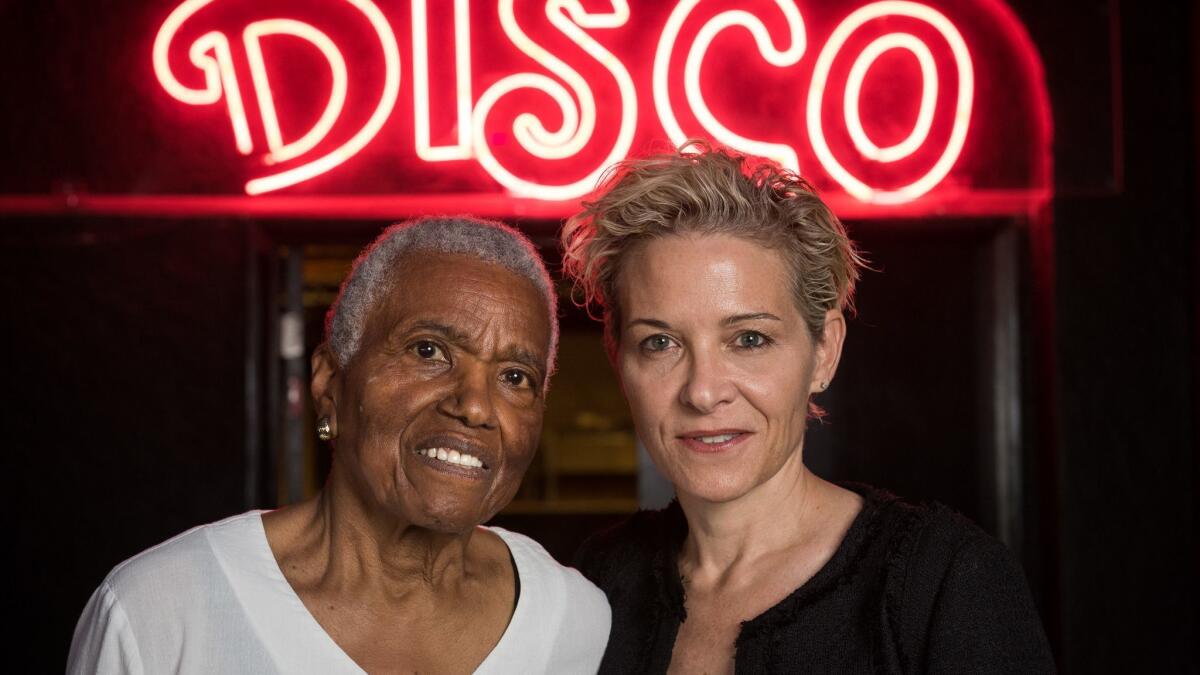The story of L.A. club Jewel’s Catch One and its pioneering owner finds its way to Netflix
- Share via
When nightclub pioneer Jewel Thais-Williams took over the building at 4067 W. Pico Blvd. in 1973, it transformed from the kind of venue where Ella Fitzgerald had to enter through the back to not offend white patrons into a spot where disco titan Sylvester could bring a full band out to play odes to black queer love.
“Just before [Fitzgerald] passed, she wanted to see the place again,” said Thais-Williams, who opened the canonical disco club Jewel’s Catch One in the same spot. “She was telling me how it was for her, how she used to have to go up the back steps and go to the back of the bar, she couldn’t go through the front door or socialize with patrons.”
She’d have had no such trouble at Jewel’s Catch One, which for a generation was perhaps the epicenter of black gay life in Los Angeles. But that’s the kind of history that too often in nightlife gets bulldozed in the name of redevelopment, changing tastes or the simple march of time.
A recent documentary on Jewel’s Catch One from director C. Fitz looks to preserve as many of those stories as possible. In rapidly gentrifying urban areas such as L.A., many of these places and memories are far too easily lost.
The eponymous doc — which debuted Tuesday on Netflix after a pickup from Ava DuVernay’s distribution firm Array — is a complex historical record of a once-in-a-lifetime nightclub. It’s a document of a physical space as well as a portrait of its stalwart and generous owner. It also captures a time when L.A. society roiled with changes around race, sexuality and music.

When the now 78-year-old Thais-Williams first opened the club’s doors, there was nowhere else like it in town: a labyrinthine dance club pitched as a place where gay patrons of color who feared the scornful eye of the LAPD could let their hair down.
And the authorities took notice. While she never wavered in her resistance and loyalty to her community, the cops never let Thais-Williams forget it.
“The film depicts a time when there was discrimination against blacks and lesbians and gays throughout,” Thais-Williams said. “There was a restriction on same sex dancing, women couldn’t tend bar unless they owned it. The police were arresting people for anything remotely homosexual. We had them coming in with guns pretending to be looking for someone in a white T-shirt just so they could walk around.
“It didn’t stop until the AIDS crisis became such that they were afraid to come in,” she added. “But it never stopped them from parking outside.”
Nonetheless, the club soon earned its spot alongside New York’s Paradise Garage and Chicago’s Warehouse as the nation’s churches for worshippers of ambitious dance music and sexual liberty.
It was a home for young, queer black people who were often spurned at home. And plenty of others wanted in: Madonna was a regular, as were Sharon Stone and Sandra Bernhard. In the film, black musicians and politicians from Evelyn “Champagne” King to Maxine Waters weigh in on its legacy.
Over time, as people fought and died for AIDS-related healthcare, civil rights (including, fundamentally, the freedom to dance and gather after dark), Jewel’s became a lighthouse for its community as much as a place to cut a rug with friends.
The documentary is a sweaty, giddy chance to walk into those rooms one last time as they were for 42 years (save a few when a fire damaged the building and destroyed much of its archives). To see that many young bodies dancing with abandon, in a time when they could be arrested for doing the same outside the Catch’s doors, is a reminder of not just how fragile rights can be, but how joyful they are when exercised.
“We tried to shoot it in a way where you feel like you’re on that dance floor,” Fitz said. “The energy, the family Jewel created, it was a home.”
For a documentarian, though, the subject was particularly challenging. The measure of a great dance club is that no one is inside filming you as you cut loose. Assembling the archival material for the documentary meant often turning to Jewel’s patrons for footage and images to fill in the gaps.
“Paparazzi wasn’t coming to Pico and Crenshaw. I never let cameras in until there were phones with cameras. And even then I didn’t want to,” Thais-Williams said.
“Thats why a lot of celebrities went there, because of Jewel’s rules,” Fitz added. “She lost a lot of footage she had from the charity balls; we had to reach out to the community and to friends, to scour libraries, everything we could. It was wild.”
The space itself is still open for dancing. Jewel sold the spot in 2015 and it soon became Union, a mostly techno-focused venue from promoter Mitch Edelson, whom Thais-Williams speaks of effusively. It’s different in there now, but so are the city’s nightlife needs.
“Audiences are diluted,” Fitz said. “In the ’70s and ’80s, there was a specific need, then needs changed. Today, younger folks don’t even know they’d want a Jewel’s because they haven’t experienced it, and that’s a shame. There’s nothing like being on that dance floor.”
Nothing can replace the Catch, or its role in L.A.’s cultural life. But the old Jewel’s sign is still up outside, and Thais-Williams sees it as a gift that you can still put on your dancing shoes and head to 4067 W. Pico Blvd.
“It was a community, it was family,” Thais-Williams said. “To be honest myself, I was pretty much a loner too. I always had the fears of coming out, or my family finding out. I found myself there.”
------------
‘Jewel’s Catch One’
Where: Netflix
When: Any time
For breaking music news, follow @augustbrown on Twitter.
More to Read
The biggest entertainment stories
Get our big stories about Hollywood, film, television, music, arts, culture and more right in your inbox as soon as they publish.
You may occasionally receive promotional content from the Los Angeles Times.











